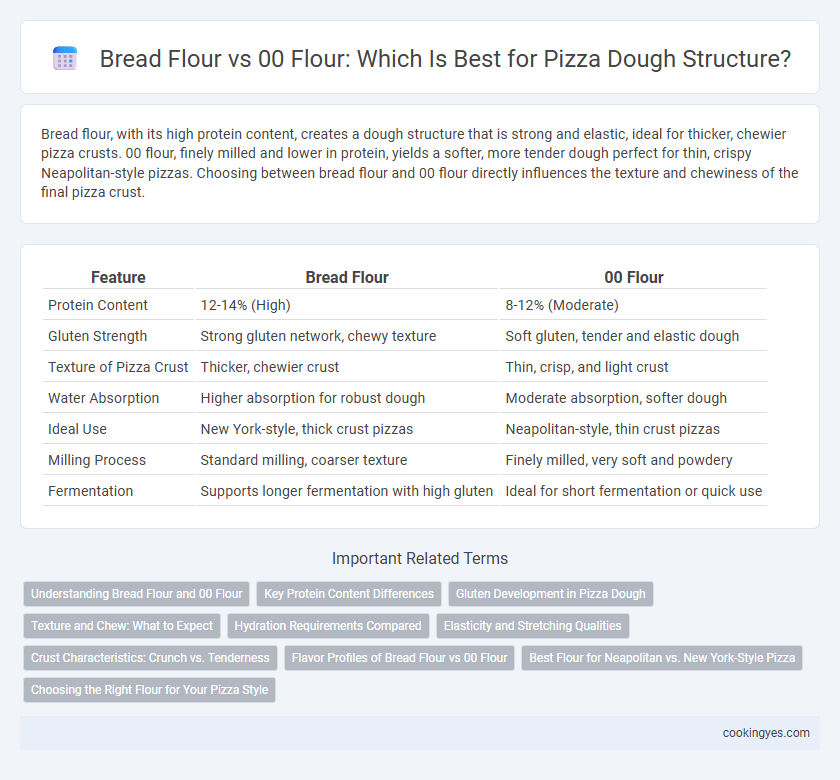Bread flour, with its high protein content, creates a dough structure that is strong and elastic, ideal for thicker, chewier pizza crusts. 00 flour, finely milled and lower in protein, yields a softer, more tender dough perfect for thin, crispy Neapolitan-style pizzas. Choosing between bread flour and 00 flour directly influences the texture and chewiness of the final pizza crust.
Table of Comparison
| Feature | Bread Flour | 00 Flour |
|---|---|---|
| Protein Content | 12-14% (High) | 8-12% (Moderate) |
| Gluten Strength | Strong gluten network, chewy texture | Soft gluten, tender and elastic dough |
| Texture of Pizza Crust | Thicker, chewier crust | Thin, crisp, and light crust |
| Water Absorption | Higher absorption for robust dough | Moderate absorption, softer dough |
| Ideal Use | New York-style, thick crust pizzas | Neapolitan-style, thin crust pizzas |
| Milling Process | Standard milling, coarser texture | Finely milled, very soft and powdery |
| Fermentation | Supports longer fermentation with high gluten | Ideal for short fermentation or quick use |
Understanding Bread Flour and 00 Flour
Bread flour contains higher protein content, typically 12-14%, which develops strong gluten networks essential for chewy, airy dough structures. 00 flour, finely milled with lower protein around 8-10%, produces a softer, more tender crust ideal for Neapolitan-style pizzas. Selecting between bread flour and 00 flour influences dough elasticity, stretchability, and final crust texture, directly affecting pizza quality.
Key Protein Content Differences
Bread flour typically contains 12-14% protein, creating a strong gluten network ideal for chewy, well-structured pizza dough. In contrast, 00 flour has a lower protein content, around 8-12%, which results in a finer, softer texture with more extensibility but less chewiness. The higher protein in bread flour enhances elasticity and rise, while 00 flour produces a tender, delicate crust favored in traditional Neapolitan-style pizzas.
Gluten Development in Pizza Dough
Bread flour contains higher protein content, typically around 12-14%, which promotes strong gluten development essential for a chewy and structured pizza dough. In contrast, 00 flour has a finer grind and lower protein content, usually between 8-10%, yielding a softer, more tender crust with less elasticity. Optimal gluten network formation in pizza dough depends on selecting the flour type aligned with the desired texture, balancing chewiness and crispness.
Texture and Chew: What to Expect
Bread flour, with its higher protein content, produces a dough with more gluten formation, resulting in a chewier texture and a more structured, elastic crumb in the pizza crust. 00 flour, finely milled and lower in protein, creates a softer, more tender dough that yields a delicate, melt-in-the-mouth texture with a lighter chew. Expect bread flour dough to hold up better to heavy toppings, while 00 flour dough offers a traditional Italian-style, airy crust with a slight crispness.
Hydration Requirements Compared
Bread flour and 00 flour differ significantly in hydration requirements due to their protein content and grind texture. Bread flour, with its higher protein level (12-14%), absorbs more water, resulting in a dough that requires around 65-75% hydration to develop strong gluten structure. In contrast, 00 flour, finely milled with lower protein (8-11%), typically needs lower hydration levels, around 55-65%, producing a softer, more extensible dough ideal for thin-crust pizzas.
Elasticity and Stretching Qualities
Bread flour contains higher protein content, typically around 12-14%, which enhances gluten development, resulting in superior elasticity and a chewy texture ideal for sturdy pizza crusts. In contrast, 00 flour has a finer grind and slightly lower protein, usually 11-12%, providing a softer, more extensible dough that stretches easily without tearing, perfect for thin, Neapolitan-style pizzas. Choosing between bread flour and 00 flour depends on the desired crust structure, balancing elasticity with smooth stretching for optimal dough performance.
Crust Characteristics: Crunch vs. Tenderness
Bread flour, high in protein and gluten, creates a crust with a robust crunch and substantial chew, ideal for thicker, artisan-style pizzas. 00 flour, finely milled with moderate protein, produces a tender, delicate crust that is thin and soft yet crisp on the edges, characteristic of traditional Neapolitan pizza. The choice between bread flour and 00 flour significantly influences dough elasticity, crust texture, and baking performance, tailoring the pizza experience from crispy to tender.
Flavor Profiles of Bread Flour vs 00 Flour
Bread flour, with its higher protein content, develops a chewier, more robust dough structure that enhances the depth of savory and nutty flavors in pizza crusts. In contrast, 00 flour, finely milled and lower in protein, yields a softer, tender dough with a delicate, slightly sweet flavor that highlights subtle wheat notes. The choice between bread flour and 00 flour directly influences the flavor complexity and texture of the finished pizza, catering to preferences for either bold, hearty profiles or light, airy crusts.
Best Flour for Neapolitan vs. New York-Style Pizza
00 flour, finely milled with lower protein content (around 11-12%), is ideal for Neapolitan pizza, producing a soft, airy crust with a tender crumb and the perfect balance of chewiness and elasticity. Bread flour, higher in protein (12-14%), develops more gluten, resulting in a chewier, more substantial dough structure favored in New York-style pizza for its characteristic foldable yet crispy crust. Choosing the right flour enhances dough extensibility and texture, key to achieving authentic regional pizza profiles.
Choosing the Right Flour for Your Pizza Style
Bread flour, with its higher protein content (12-14%), develops a strong gluten network that creates a chewy, airy crust ideal for New York-style pizza. 00 flour, finely milled with moderate protein (8-12%), produces a soft, tender dough perfect for Neapolitan pizza's thin, delicate crust. Selecting the right flour depends on desired crust texture and pizza style, balancing gluten strength with dough extensibility for optimal results.
Bread Flour vs 00 Flour for dough structure Infographic

 cookingyes.com
cookingyes.com